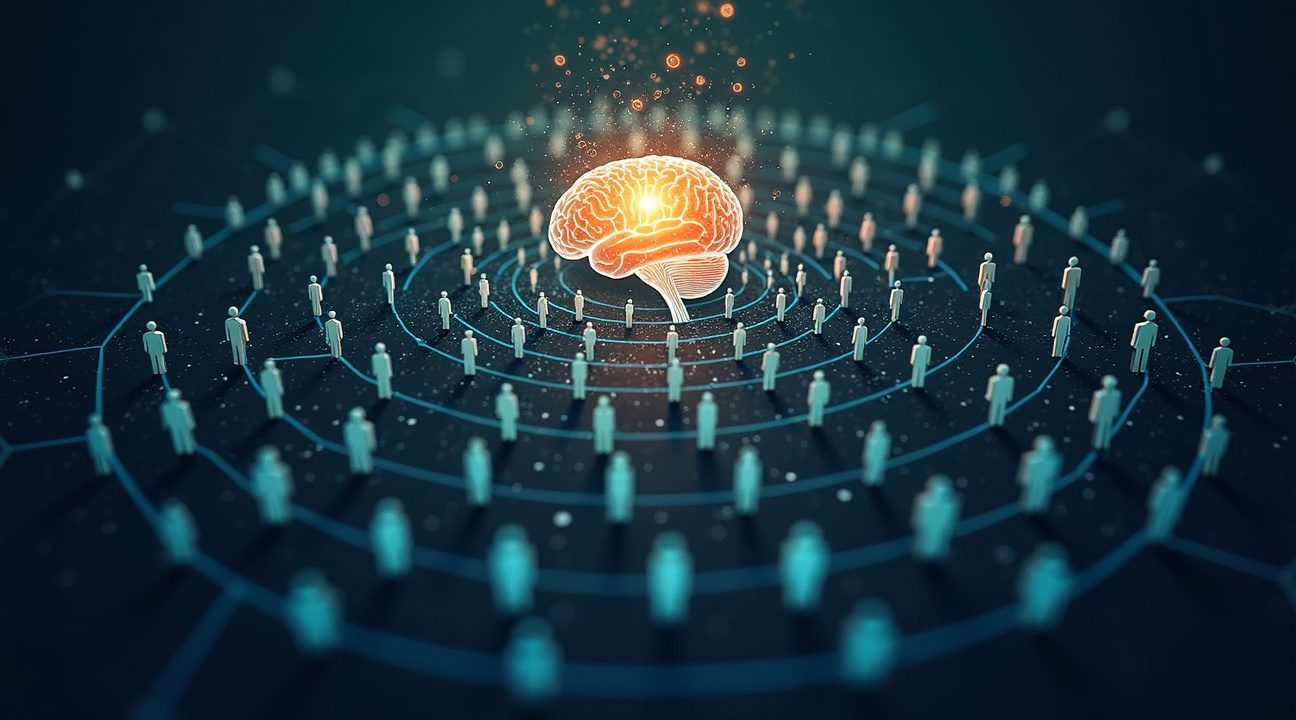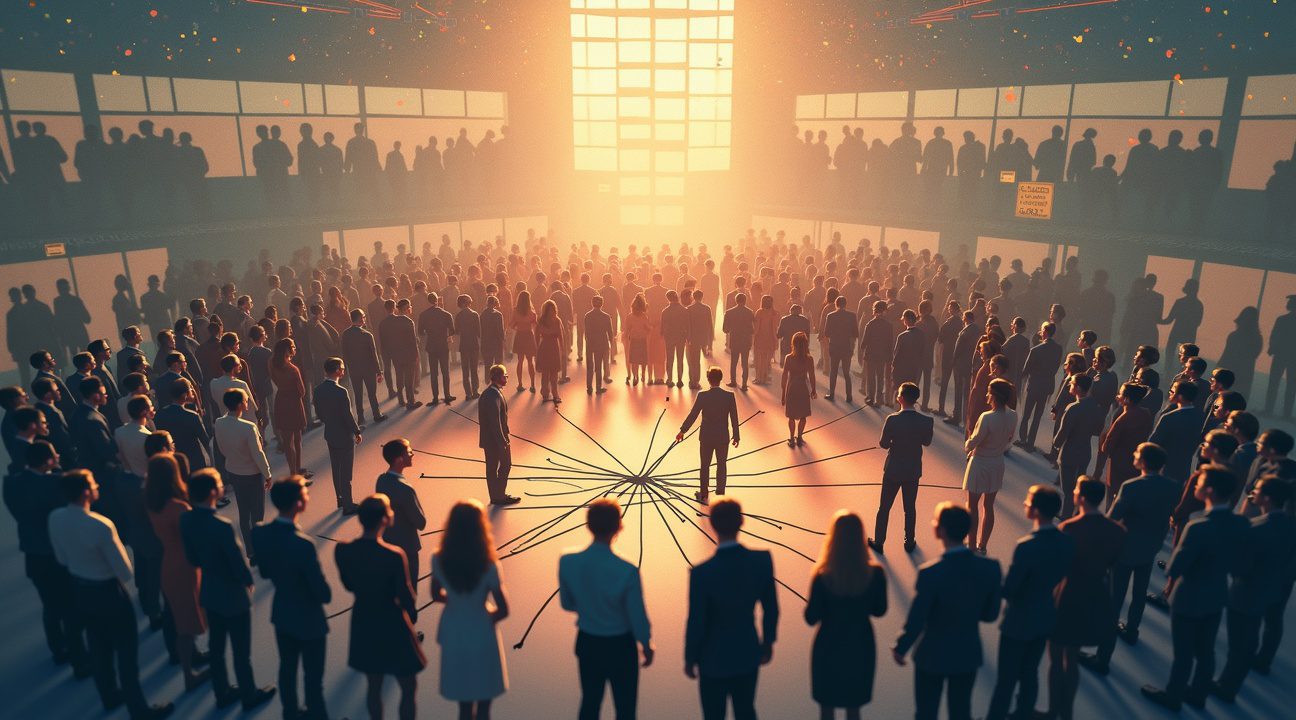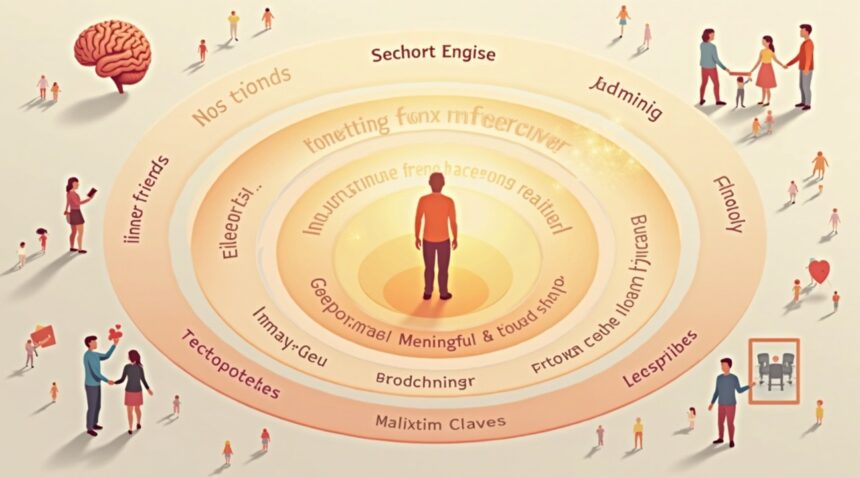British anthropologist Robin Dunbar’s groundbreaking research revealed that the human brain can manage approximately 150 meaningful relationships at any given time. This cognitive boundary stems from neurological architecture rather than cultural preferences. This limitation, known as Dunbar’s Number, emerged from studies examining the correlation between neocortex size in primates and their social group sizes. The research demonstrates that larger brain regions dedicated to social processing correspond directly with bigger social groups.
Key Takeaways
- The 150 limit represents genuine, stable relationships that require ongoing mental investment, including family members, close friends, and regular colleagues people interact with meaningfully.
- Social connections form distinct layers from a person’s innermost circle of 1-2 closest relationships to broader networks of 500 acquaintances and 1,500 recognizable faces.
- This cognitive boundary is biological, not cultural, stemming from evolutionary constraints that shaped human brain development for managing complex social relationships in smaller communities.
- Social media doesn’t overcome these limitations — while digital platforms allow contact with thousands, the brain still processes only around 150 as genuine relationships requiring emotional investment.
- Organizations and communities function most effectively when structured around the 150-person threshold, with military units, businesses, and traditional settlements naturally organizing around this number for optimal communication and trust.
To learn more about Dunbar’s Number and the research behind it, visit this detailed discussion on Scientific American.
Why Your Brain Can Only Handle 150 Real Friends: The Science Behind Human Connection Limits
I’ve discovered something fascinating about human social limitations that might explain why maintaining large social circles feels exhausting. British anthropologist Robin Dunbar uncovered a remarkable cognitive boundary that affects every person’s social life. His research revealed that the human brain can manage approximately 150 meaningful relationships at any given time.
This discovery didn’t happen by accident. Dunbar examined the correlation between neocortex size in primates and their average social group sizes. The findings showed a clear pattern: larger brain regions dedicated to social processing corresponded directly with bigger social groups. Humans, with their proportionally large neocortex, topped out at around 150 stable relationships.
Understanding What Counts as a Meaningful Connection
The 150 figure represents genuine, stable relationships that require ongoing mental investment. These connections include family members, close friends, work colleagues you interact with regularly, and other people you know well enough to approach comfortably in social settings. I find it helpful to think of these as relationships where you remember personal details about each person and feel comfortable reaching out to them directly.
This cognitive limit explains several phenomena most people experience:
- Why maintaining college friendships becomes harder after graduation
- Why large social media networks feel overwhelming despite their digital nature
- Why expanding professional networks requires letting some personal relationships fade
- Why people naturally drift apart from acquaintances when life circumstances change
- Why joining new communities often means reducing involvement in existing ones
The number isn’t arbitrary or cultural – it’s biological. Your brain simply lacks the processing power to track more complex social relationships simultaneously. Social network size appears hardwired into human neurological architecture.
Dunbar’s research established what scientists now call Dunbar’s Number, which has become a cornerstone of understanding human social behavior. The finding challenges modern assumptions about friendship and connection in an increasingly connected world.
Modern technology hasn’t changed this fundamental limitation. Social media platforms may facilitate contact with thousands of people, but your brain still processes only 150 as genuine relationships. The rest remain superficial connections that don’t engage the same neural pathways responsible for meaningful social bonds.
This cognitive constraint affects relationship quality too. When someone tries to maintain more than 150 active relationships, the quality of individual connections typically decreases. Cognitive science research shows that spreading social attention too thin leads to shallower, less satisfying relationships overall.
The implications extend beyond personal life into professional contexts. Teams larger than 150 people require formal hierarchies and systems because informal social coordination breaks down. Military units, successful companies, and even religious communities often organize around this natural limit.
Understanding this boundary can actually improve your social life. Instead of feeling guilty about losing touch with distant acquaintances, you can focus energy on nurturing your core 150 relationships. Meaningful relationships require regular maintenance through shared experiences, communication, and emotional investment.
The research also validates the common experience of relationship seasons. As life changes – new jobs, moves, marriage, children – your roster of 150 naturally evolves. Some relationships fade while others strengthen or develop. This isn’t social failure; it’s biological necessity.
The social brain hypothesis suggests that managing these complex relationships was actually a driving force in human brain evolution. Our ancestors needed sophisticated social intelligence to survive in groups, leading to the enlarged neocortex that creates our modern relationship limits.
Recognizing these constraints helps explain why authentic connection feels increasingly rare in our hyperconnected age. Your brain evolved for smaller, tighter communities where everyone knew everyone else. Today’s sprawling social networks often overwhelm this ancient system, creating stress and shallow connections that leave people feeling isolated despite having hundreds of online “friends.”
The key lies in working with your brain’s natural limitations rather than against them. Prioritizing quality over quantity in relationships aligns with your neurological design and typically leads to greater social satisfaction and emotional wellbeing.

The Hidden Layers of Your Social Circle: From Your Inner 5 to Your Outer 1,500
Social connections don’t exist as a flat network but instead form distinct layers around each person, much like concentric circles radiating outward from a central point. Robin Dunbar’s research revealed that human cognitive limitations create predictable patterns in how people organize their relationships, with each layer serving different emotional and practical functions.
The Core Layers: Your Most Important Connections
At the very center of your social universe sit 1-2 special friends who represent your closest emotional ties. These relationships often involve romantic partners, life partners, or exceptionally close family members who provide the deepest level of intimacy and emotional support. They’re the people you turn to during your most vulnerable moments and share your most private thoughts with.
Surrounding this innermost circle, your support clique consists of approximately 5 people who form your primary emotional and practical support system. This group typically includes your closest family members, best friends, or trusted confidants who actively participate in your major life decisions. They offer both emotional comfort during difficult times and practical assistance when you need help navigating life’s challenges.
The next layer expands to include about 15 good friends — people you confide in regularly and maintain strong emotional bonds with. These relationships involve frequent communication, shared experiences, and mutual support during both good times and difficult periods. You feel comfortable discussing personal matters with this group and often seek their advice on important decisions.
Extended Networks: Broader Social Connections
Moving outward, your circle of 50 close friends encompasses people you maintain regular meaningful interactions with throughout the year. These relationships might include work colleagues you’ve grown close to, longtime neighbors, college friends you stay in touch with, or extended family members you see regularly. While not as intimate as your inner circles, these connections provide social enrichment and occasional support.
The famous 150 number represents your complete network of meaningful stable relationships. This layer includes all friends, family members, and regular contacts you can maintain genuine relationships with over time. Research shows that brain capacity limits prevent most people from exceeding this number without losing track of important details about individuals in their network.
Beyond the 150 threshold, your social landscape becomes less personal. Your network of 500 acquaintances includes people you interact with less frequently but still maintain some level of ongoing connection with. These might be former colleagues, distant relatives, old school friends, or people you’ve met through various activities but don’t regularly communicate with.
Finally, your broader recognition network extends to approximately 1,500 people whose faces you recognize and can attach names to, though you know them only superficially. This group includes neighbors you rarely speak with, people you’ve met at events, distant acquaintances from various life periods, and individuals you encounter regularly but don’t have meaningful conversations with.
Understanding Dunbar’s number helps explain why maintaining relationships becomes increasingly difficult as your social circle grows. Each layer requires different amounts of emotional investment and time commitment, with your inner circles demanding significantly more attention than your outer networks. These nested numbers reflect natural patterns in how humans organize their social world, allowing you to allocate your limited social resources effectively across different types of relationships.
From Primates to Military Units: The Evolutionary Roots of the 150 Rule
Dunbar’s groundbreaking research began with careful observation of our closest evolutionary relatives. His primate studies revealed a fascinating correlation between brain structure and social organization. Species with larger neocortexes consistently formed bigger, more intricate social groups, which enabled better cooperation and survival advantages. This relationship between brain capacity and social connections provided the foundation for understanding human social limitations.
When Dunbar applied this same principle to humans, the mathematics pointed consistently to 150 as the optimal group size for maintaining stable relationships. This figure represents the cognitive ceiling where individuals can track personal histories, recognize social hierarchies, and maintain meaningful bonds with each group member. The social brain hypothesis explains why our neocortex evolved specifically to handle these complex social calculations.
Historical Evidence Across Cultures
Archaeological and anthropological evidence supports this 150-person limit across diverse human societies. Hunter-gatherer bands throughout history have naturally organized around this number, suggesting an innate biological constraint rather than cultural coincidence. Traditional villages from various continents show remarkably similar population structures, with core communities hovering around 150 residents who maintained close, interconnected relationships.
Military organizations have independently discovered this principle through practical necessity. Roman legions, medieval armies, and modern military units consistently organize effective fighting forces around 150 soldiers. These groups demonstrate optimal communication, trust, and coordination when kept within Dunbar’s number parameters.
Modern Applications and Corporate Structure
Contemporary business organizations often struggle when departments exceed 150 employees. Companies that maintain smaller divisions report better internal communication, stronger team cohesion, and more efficient problem-solving capabilities. Some successful corporations deliberately structure their workforce around this principle, creating multiple 150-person units rather than massive departments.
The consistency of this pattern across different contexts – from ancient tribes to modern corporations – demonstrates the brain’s cognitive limitations in processing social information. Understanding these evolutionary constraints helps explain why maintaining large social networks becomes increasingly difficult and why meaningful relationships require careful cultivation and attention.
This evolutionary perspective reveals that our social limitations aren’t personal failings but biological realities shaped by millions of years of development. Recognizing these constraints allows for more realistic expectations about relationship maintenance and social network management in our increasingly connected world.

Your Personal 150: Why Some People Manage More Friends Than Others
Natural variation in social capacity means that meaningful relationships aren’t limited to exactly 150 for everyone. Individual differences in personality, circumstances, and social environments create a spectrum where some people thrive with 200 connections while others feel overwhelmed at 100.
Extroverts consistently demonstrate higher capacity for maintaining social networks compared to their introverted counterparts. These outgoing individuals naturally gravitate to social situations, process multiple relationships simultaneously with greater ease, and often sustain connections across various social circles. Introverts, conversely, invest deeper energy into fewer relationships and typically find their sweet spot closer to the lower end of the 100-200 range.
Circumstances Shape Social Network Size
Life circumstances dramatically influence how many relationships a person can realistically maintain. Consider these factors that affect your personal number:
- Geographic transitions and migration patterns temporarily reduce social networks until new stable communities form
- Career changes or life stage transitions often force relationship pruning as priorities shift
- Cultural backgrounds influence relationship expectations and maintenance styles
- Technological tools either enhance or complicate relationship management depending on usage patterns
- Available time and energy fluctuate based on work demands, family obligations, and health status
Dunbar’s Number functions as a guideline rather than a rigid biological ceiling. Research shows that cognitive limitations create natural boundaries, but these boundaries bend based on individual circumstances and social demands.
Migrants exemplify how context dramatically affects social capacity. During transition periods, they often experience network shrinkage as distance makes previous relationships harder to maintain. However, once they establish roots in new communities, their networks can expand again, sometimes exceeding their pre-migration numbers due to bicultural connections.
Technology adds another layer of complexity to personal relationship limits. Digital platforms allow superficial maintenance of larger networks, but these tools can either supplement or substitute for deeper connections depending on how people use them. Some individuals leverage technology to exceed traditional limits by efficiently managing relationship maintenance, while others find digital overwhelm reduces their actual capacity for meaningful connections.
Your personal 150 reflects a unique combination of personality traits, life circumstances, and social environment. Understanding brain capacity limitations helps set realistic expectations for relationship management while recognizing that flexibility exists within those constraints.

How Social Media Challenges but Doesn’t Break the 150 Limit
Social media platforms have fundamentally changed how people connect, leading many to question whether Dunbar’s number still applies in our digital age. Facebook, Instagram, and LinkedIn users often accumulate hundreds or thousands of connections, seemingly surpassing the traditional 150-relationship limit. However, research reveals that these massive digital networks don’t actually challenge the core principles behind meaningful relationship capacity.
The Quality Gap in Digital Networks
Studies examining Facebook usage patterns demonstrate a clear distinction between connection quantity and relationship quality. Users who maintain over 1,000 Facebook friends typically engage meaningfully with only a small fraction of their network. Research shows that even among heavy social media users, the number of emotionally significant relationships remains consistent with traditional patterns. Most digital connections represent acquaintances rather than the deep, invested relationships that count toward meaningful relationship capacity.
The average Facebook friend count actually aligns remarkably well with the 150 limit when researchers examine active engagement patterns. People consistently interact with, remember personal details about, and maintain emotional investment in roughly the same number of individuals regardless of their total connection count. Social platforms amplify our ability to stay loosely connected with larger groups, but they don’t expand our capacity for deep, reciprocal relationships that require significant cognitive and emotional resources.
Why Digital Connections Don’t Count
The human brain’s cognitive limitations remain unchanged despite technological advances. Meaningful relationships require substantial mental effort to maintain – remembering personal histories, tracking emotional states, understanding individual personalities, and investing time in regular communication. These cognitive demands create natural boundaries that social media cannot overcome.
Research findings consistently show that only emotionally engaged connections qualify for inclusion in our core social network. Consider these key characteristics that distinguish meaningful relationships from digital contacts:
- Regular, substantive communication that goes beyond likes and brief comments
- Detailed knowledge of personal circumstances, goals, and challenges
- Emotional investment and genuine concern for the other person’s wellbeing
- Reciprocal support during difficult times or major life events
- Shared experiences that create lasting memories and deeper bonds
Digital platforms excel at maintaining weak ties – those casual connections that provide information, opportunities, and social awareness. These relationships serve important functions but require minimal cognitive investment. A former colleague’s job update or a distant friend’s vacation photos don’t demand the same mental resources as supporting a close friend through a divorce or celebrating a family member’s achievements.
The social brain hypothesis explains why technological tools can’t expand our relationship capacity. Our brains evolved specific neural pathways for processing social information, and these systems have finite bandwidth. While social media helps us process more superficial social data, it doesn’t increase our ability to form or maintain deep emotional bonds.
Even professional networking platforms like LinkedIn demonstrate this pattern. Users may connect with hundreds of colleagues and industry contacts, but they typically maintain meaningful professional relationships with far fewer individuals. The connections that influence career decisions, provide mentorship, or offer genuine collaboration opportunities usually number well within traditional limits.
Social network size and brain capacity research reinforces that our neurological architecture sets relationship boundaries. Technology changes how we communicate and stay informed about others, but it doesn’t alter fundamental cognitive constraints. People who attempt to maintain genuinely close relationships with hundreds of individuals often experience social fatigue and declining relationship quality across their entire network.
The persistence of the 150 limit in digital environments actually validates cognitive science research on social connections. Despite unprecedented connectivity tools, humans continue to invest their deepest social energy in relatively small groups. Social media serves as an excellent tool for maintaining awareness of larger networks and facilitating occasional reconnection, but it doesn’t replace or expand our core relationship capacity.
This understanding helps explain why many heavy social media users report feeling lonely despite their extensive online networks. Quantity of connections doesn’t substitute for quality of relationships, and our brains still require the same level of meaningful social interaction that has sustained human communities for millennia.
Real-World Applications: Why Organizations Thrive at 150 and Face Challenges Beyond
The 150-person threshold has profound implications for how organizations structure themselves and maintain effectiveness. I’ve observed countless businesses struggle when they exceed this natural boundary without implementing proper structural adjustments. Military units provide compelling evidence of this principle in action – companies typically maintain around 150 soldiers because this size enables commanders to know each individual personally and foster the trust essential for battlefield cohesion.
Hutterite settlements offer another striking example of this cognitive limit at work. These communities systematically split when their population approaches 150 members, recognizing that maintaining personal relationships becomes increasingly difficult beyond this point. The practice has allowed them to preserve their close-knit social fabric for generations while avoiding the conflicts and fragmentation that often plague larger communities.
Business Structures That Honor Cognitive Limits
Modern companies are increasingly recognizing the value of organizing around Dunbar’s number principles. Technology firms like Gore & Associates have built their entire organizational philosophy around keeping operating units under 150 people. This approach allows leadership to maintain meaningful connections with team members while preserving the informal communication networks that drive innovation and problem-solving.
The benefits extend beyond mere organizational chart aesthetics. Teams operating within these parameters demonstrate:
- Higher employee satisfaction and retention rates
- Faster decision-making processes due to reduced bureaucratic layers
- Stronger collaborative relationships that transcend formal reporting structures
- More effective knowledge transfer and institutional memory preservation
- Reduced workplace conflict and improved conflict resolution
Cultural and Technological Challenges to Traditional Models
Recent scholarship has introduced important nuances to the rigid 150-person model. Cultural anthropologists note significant variations in social capacity across different societies, suggesting that cognitive limitations aren’t universally fixed. Digital communication tools have also altered how humans maintain relationships, potentially expanding our capacity for meaningful connections beyond traditional face-to-face interactions.
Mental health professionals increasingly leverage these insights when designing support systems and therapeutic communities. Rather than maximizing network size, successful programs focus on cultivating deeper connections within manageable groups. This approach proves particularly effective for addiction recovery programs and trauma support networks, where trust and emotional intimacy are crucial for healing.
Some researchers question whether the specific number 150 represents a universal cognitive cap or merely reflects the social conditions of particular historical periods. Brain capacity research suggests that while humans do face definite limitations in processing social information, these boundaries might shift based on social complexity and available emotional energy.
Contemporary studies continue to validate the core principle while acknowledging variations. The precise number may fluctuate between 100 and 250 depending on factors like communication methods, cultural norms, and individual differences in social processing abilities. What remains consistent is the existence of meaningful boundaries that organizations ignore at their peril.
Companies that attempt to operate as single cohesive units beyond these limits often experience decreased productivity, increased bureaucracy, and weakened company culture. Smart organizations respond by creating sub-units, implementing matrix structures, or developing satellite offices that maintain the benefits of intimate working relationships while achieving larger-scale objectives.
The implications for community design are equally significant. Urban planners and social architects who understand cognitive-social limits create neighborhoods, schools, and public spaces that encourage natural social groupings rather than overwhelming individuals with too many potential connections. This approach leads to stronger community bonds and more sustainable social environments.

Sources:
ModelThinkers, “Dunbar’s Number – ModelThinkers”
RUMS Review, “How Many Friends Can You Really Have?”
Research Outreach, “Size Matters: The Link between Social Groups and Human Evolution”
PMC, “Dunbar’s number deconstructed”
Social Science Space, “Robin Dunbar Explains Why His ‘Number’ Still Counts”


